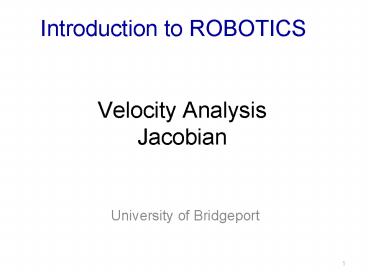Velocity Analysis Jacobian - PowerPoint PPT Presentation
Title:
Velocity Analysis Jacobian
Description:
... it is not a constant! ... than full rank Jacobian is non-invertable Boundary Singularities: occur when the tool tip is on the surface of the work envelop. – PowerPoint PPT presentation
Number of Views:272
Avg rating:3.0/5.0
Title: Velocity Analysis Jacobian
1
Velocity AnalysisJacobian
Introduction to ROBOTICS
- University of Bridgeport
1
2
Kinematic relations
XFK(?)
? IK(X)
Task Space
Joint Space
Location of the tool can be specified using a
joint space or a cartesian space description
3
Velocity relations
- Relation between joint velocity and cartesian
velocity. - JACOBIAN matrix J(?)
Task Space
Joint Space
4
Jacobian
- Suppose a position and orientation vector of a
manipulator is a function of 6 joint variables
(from forward kinematics) - X h(q)
5
Jacobian Matrix
Forward kinematics
6
Jacobian Matrix
Jacobian is a function of q, it is not a constant!
7
Jacobian Matrix
The Jacbian Equation
8
Example
- 2-DOF planar robot arm
- Given l1, l2 , Find Jacobian
9
Singularities
- The inverse of the jacobian matrix cannot be
calculated when - det J(?) 0
- Singular points are such values of ? that cause
the determinant of the Jacobian to be zero
10
- Find the singularity configuration of the 2-DOF
planar robot arm
determinant(J)0 Not full rank
11
Jacobian Matrix
- Pseudoinverse
- Let A be an mxn matrix, and let be the
pseudoinverse of A. If A is of full rank, then
can be computed as
12
Jacobian Matrix
- Example Find X s.t.
Matlab Command pinv(A) to calculate A
13
Jacobian Matrix
- Inverse Jacobian
- Singularity
- rank(J)ltn Jacobian Matrix is less than full
rank - Jacobian is non-invertable
- Boundary Singularities occur when the tool tip
is on the surface of the work envelop. - Interior Singularities occur inside the work
envelope when two or more of the axes of the
robot form a straight line, i.e., collinear
14
Singularity
- At Singularities
- the manipulator end effector cant move in
certain directions. - Bounded End-Effector velocities may correspond to
unbounded joint velocities. - Bounded joint torques may correspond to unbounded
End-Effector forces and torques.
15
Jacobian Matrix
- If
- Then the cross product
16
Remember DH parmeter
- The transformation matrix T
17
Jacobian Matrix
18
Jacobian Matrix
- 2-DOF planar robot arm
- Given l1, l2 , Find Jacobian
- Here, n2,
19
- Where (?1 ?2 ) denoted by ?12 and
19
20
Jacobian Matrix
- 2-DOF planar robot arm
- Given l1, l2 , Find Jacobian
- Here, n2
21
Jacobian Matrix
22
Jacobian Matrix
23
Jacobian Matrix
The required Jacobian matrix J
24
Stanford Manipulator
The DH parameters are
25
Stanford Manipulator
26
Stanford Manipulator
T4 c1c2c4-s1s4, -c1s2,
-c1c2s4-s1c4, c1s2d3-sin1d2 s1c2c4c1s4,
-s1s2, -s1c2s4c1c4, s1s2d3c1d2 -s2c4, -c2,
s2s4, c2d3 0, 0, 0, 1
27
Stanford Manipulator
T5 (c1c2c4-s1s4)c5-c1s2s5, c1c2s4s1c4,
(c1c2c4-s1s4)s5c1s2c5,
c1s2d3-s1d2 (s1c2c4c1s4)c5-s1s2s5,
s1c2s4-c1c4, (s1c2c4c1s4)s5s1s2c5,
s1s2d3c1d2 -s2c4c5-c2s5, -s2s4,
-s2c4s5c2c5, c2d3 0, 0, 0, 1
28
Stanford Manipulator
T5 (c1c2c4-s1s4)c5-c1s2s5, c1c2s4s1c4,
(c1c2c4-s1s4)s5c1s2c5,
c1s2d3-s1d2 (s1c2c4c1s4)c5-s1s2s5,
s1c2s4-c1c4, (s1c2c4c1s4)s5s1s2c5,
s1s2d3c1d2 -s2c4c5-c2s5, -s2s4,
-s2c4s5c2c5, c2d3 0, 0, 0, 1
29
Stanford Manipulator
T6 c6c5c1c2c4-c6c5s1s4-c6c1s2s5s6c1c2s4s6s1
c4, -c5c1c2c4s6c5s1s4s6c1s2s5c6c1c2s4c6s1c4,
s5c1c2c4-s5s1s4c1s2c5, d6s5c1c2c4-d6s5s1s4d6c1s2
c5c1s2d3-s1d2 c6c5s1c2c4c6c5c1s4-c6s1s2s5s6
s1c2s4-s6c1c4, -s6c5s1c2c4-s6c5c1s4s6s1s2s5c6s1c
2s4-c6c1c4, s5s1c2c4s5c1s4s1s2c5,
d6s5s1c2c4d6s5c1s4d6s1s2c5s1s2d3c1d2
-c6s2c4c5-c6c2s5-s2s4s6, s6s2c4c5s6c2s5-s2s4c6,
-s2c4s5c2c5, -d6s2c4s5d6c2c5c2d3 0, 0,
0, 1
30
Stanford Manipulator
Joints 1,2 are revolute
Joint 3 is prismatic
The required Jacobian matrix J
31
Inverse Velocity
- The relation between the joint and end-effector
velocities - where j (mn). If J is a square matrix (mn), the
joint velocities - If mltn, let pseudoinverse J where
32
Acceleration
- The relation between the joint and end-effector
velocities - Differentiating this equation yields an
expression for the acceleration - Given of the end-effector acceleration, the
joint acceleration































